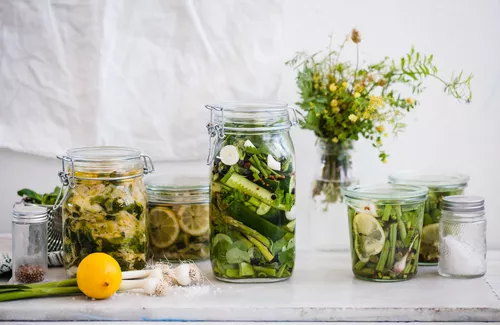- What is fermentation?
- Appropriate container and vaccination
- Salt as an additional ingredient
- Suitable wild herbs
- herbs from the garden
- What is to be considered?
- This is how wild herbs are fermented
Wild herbs and fermentation. Both are in demand again in today's nutrition-conscious times. And fortunately, they can also be combined well. While the herbs provide valuable ingredients in the spring, fermentation makes them durable for a long time. But how does that work?
 Wild herbs can be fermented like vegetables
Wild herbs can be fermented like vegetables
What is fermentation?
During fermentation, harmless bacterial or fungal cultures trigger a fermentation process. The vegetables are changing, but they remain or even become a bit healthier. In most cases, this creates an acid that ensures a long shelf life. Edible wild herbs can also be fermented. This closes the supply gap during the cold season.
Appropriate container and vaccination
A fermenting pot with a lid, like the one used to make sauerkraut, is also ideal for fermenting wild herbs. Furthermore, the contents are “vaccinated” with fresh sauerkraut juice. But that is not absolutely necessary. The herbal mixture will also start to ferment on its own at some point, since a few of the beneficial bacteria and fungi are always involved.
Salt as an additional ingredient
Rock salt is a common ingredient in making fermented vegetables, but is not a requirement. However, it offers convincing advantages, even with wild herbs.
- it keeps the herbs crisp
- allows the fermentation process to run more smoothly
- adds its own flavor note
Suitable wild herbs
All kinds of wild herbs can be fermented. It is interesting to combine different types. But be careful: Only use wild herbs that you know really well, otherwise poisonous wild herbs can easily end up in the fermentation pot by mistake.
Collecting wild herbs is particularly worthwhile in spring. Then very many species are willing to give us their gifts. It also takes a lot to completely fill the fermenter.
herbs from the garden
Cultivated garden herbs such as parsley can also be added to the pot. Garlic adds an interesting flavor note. If you take a closer look, you can also discover wild herbs in the garden that have settled there all by themselves.
What is to be considered?
Wild herbs are mainly collected for their healthy and often healing properties. However, if they come from inappropriate places, harmful substances can stick to them.
- Use unsprayed wild herbs
- do not pick close to cultivated fields
- Avoid near busy roads
This is how wild herbs are fermented
- Wash wild herbs thoroughly
- then chop everything up
- place a 4 cm layer in the fermentation pot
- add some salt
- fill it up layer by layer
- tamp each layer extensively beforehand
- vaccinate with sauerkraut
- weigh down with a clean stone
- Keep container warm
After the fermentation process is complete, the wild herbs can be eaten. This is usually the case after a few days or weeks.
tips
If the herbs are not completely covered by liquid, you can top up with some spring water.